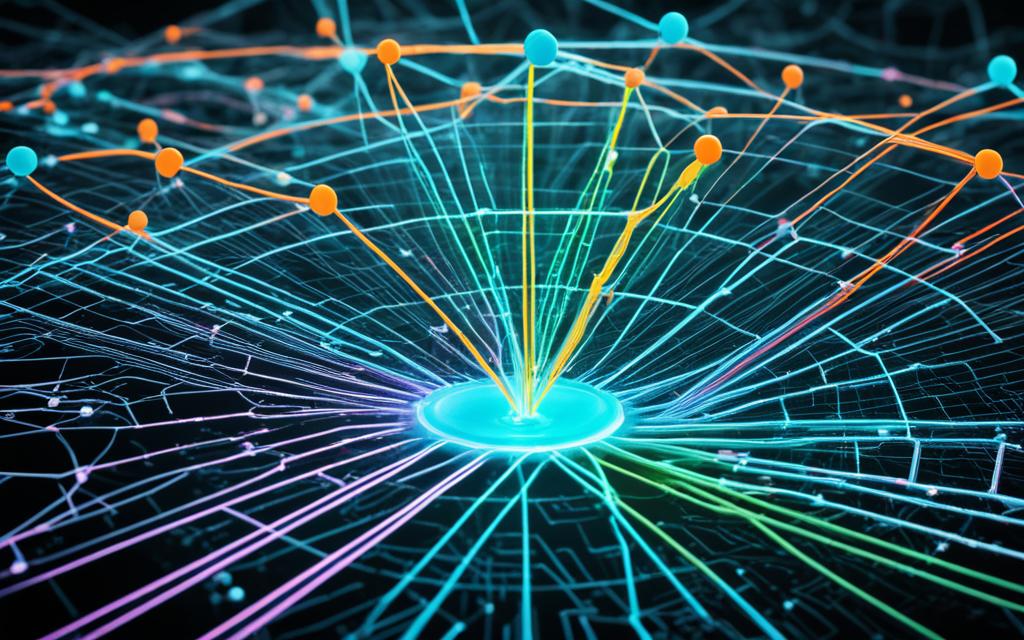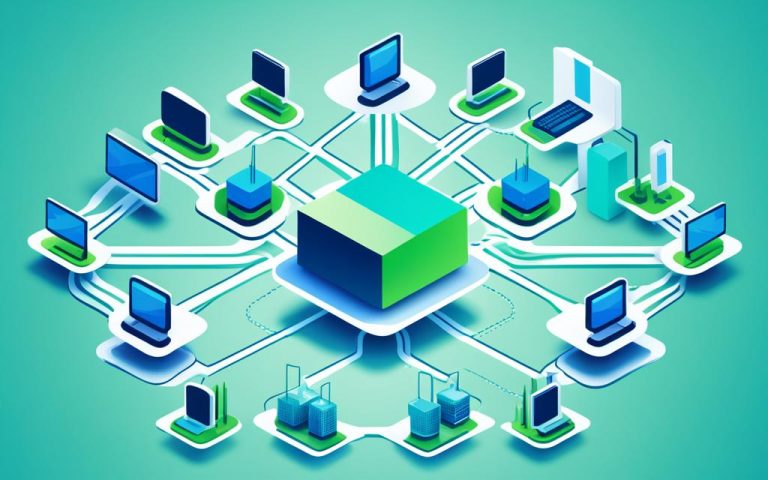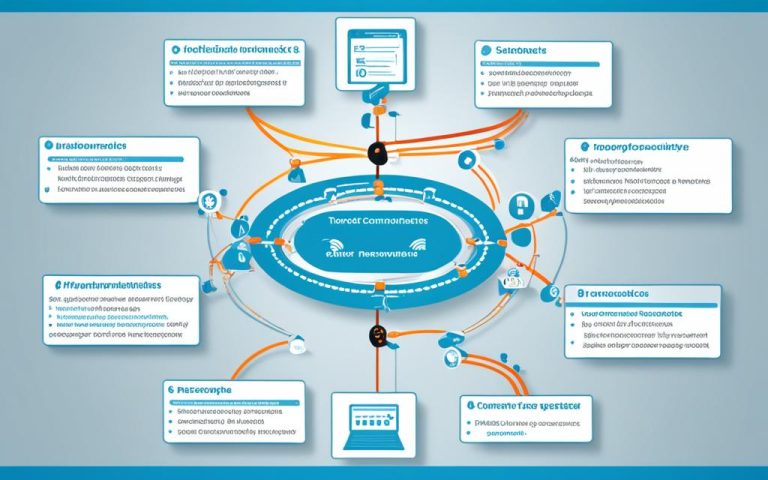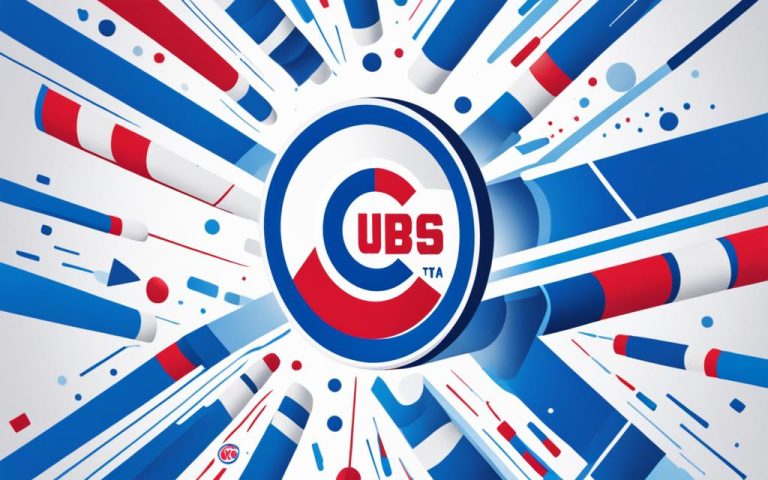Millimeter wave backscatter networks are changing wireless communication. They offer many uses and benefits. These networks let devices talk back and forth and pinpoint locations using special technology in the millimeter wave range.
Backscatter nodes work by changing and reflecting signals. This makes them great for uses that need little power and efficient communication. For example, MilBack, a new network, can pinpoint locations and send and receive data well. It uses only 32 mW to send data and 18 mW to receive it, up to 8 meters away1.
MilBack was created by UCLA researchers. It’s a big step forward in mmWave backscatter technology. Old mmWave backscatter systems couldn’t accurately locate devices or send and receive signals. But MilBack does all three well and uses little power1.
MilBack uses a new way to change and read signals called OAQFM. This tech makes it easy and uses less energy. It solves the problems that made old backscatter networks hard to use at mmWave frequencies1.
These networks have many uses. They can make 5G networks better and help with IoT, tracking items, checking building health, and fitness trackers1.
Key Takeaways:
- Millimeter wave backscatter networks enable two-way communication and precise localization using innovative backscatter technology.
- MilBack, a pioneering network, achieves accurate localization, uplink, and downlink communication while consuming low power1.
- The integration of the OAQFM modulation scheme enables efficient signal modulation and demodulation in MilBack1.
- Existing mmWave backscatter solutions often lack the capacity to provide all critical functionalities, but MilBack addresses these limitations1.
- Millimeter wave backscatter networks have potential applications in various sectors, including 5G networks, IoT, and inventory management1.
Stay tuned for the next section, where we will delve deeper into the principles of millimeter wave backscatter communication and explore its advantages in more detail.
Introduction to Millimeter Wave Backscatter Networks
Millimeter wave backscatter networks are a new way to send data fast and use little power. They solve the problems of old wireless networks by offering more speed and less power use. By using millimeter waves and backscatter tech, these networks make fast, low-power wireless links.
Old wireless networks like WiFi and Bluetooth have limits on how fast they can send data and how much power they use. But, millimeter wave tech works at high frequencies and can send data faster. The problem is making these networks use less power for devices that need to save energy.
Statistical data2 shows that current mmWave systems use 10-20 watts, but mmTag’s devices use just a few milliwatts. This makes mmTag perfect for devices that need to save energy. Backscatter devices in these networks use very little energy to send data, using only 2.4 nJ per bit.
To talk to each other, mmWave nodes need to line up their signals. But, making these signals strong uses a lot of power. mmTag uses a special technique called the Van Atta method to fix this without using a lot of power. This lets them send data more efficiently. They also use polarization to deal with interference and keep the signal strong, sending data fast and using very little power.
Millimeter wave backscatter networks send data much faster than other backscatter tech. Data3 shows most backscatter tech sends data slower than 1Mb/s. But, mmTag can send data at 1 Gbps and 100 Mbps over short distances.
The mmWave band has a lot of unused spectrum, 200 times more than WiFi and RFID use. This means mmWave backscatter networks can use a lot of spectrum, from 0 to 14 GHz. This is much more than the spectrum used by 900 MHz and 2.4 GHz networks, as shown by data4.
Millimeter wave backscatter networks can send data fast and use very little power. This makes them great for many uses. We will look at how they work, their benefits, where they’re used, the challenges they face, and the latest research on them. This will give you a full picture of this exciting wireless tech.
Principles of Millimeter Wave Backscatter Communication
The core idea of millimeter wave backscatter communication is changing the load of the backscatter antenna to modulate the incoming signal.
This change lets the tag send its own info by switching loads. It can do amplitude or phase modulation of the signal it sends back.
The antenna uses the reflection coefficient and the incoming signal to change the signal’s strength and phase.
This method, called modulated backscatter, lets the tag add its data to the incoming signal.
Modulated backscatter is often used in tags that change impedance to send data over millimeter waves.
This method helps send data over millimeter wave systems, making the most of the bandwidth available3.
Table: Comparison of Millimeter Wave Backscatter Communication Technologies
| Technology | Data Transfer Rate | Channel Bandwidth | Power Consumption |
|---|---|---|---|
| Millimeter Wave Backscatter | Up to 2 Gbps5 | 200x greater bandwidth than WiFi and RFID3 | Low power consumption2 |
| Conventional Backscatter | Less than 1 Mbps3 | 500 KHz3 | Higher power consumption3 |
Millimeter wave backscatter systems have big advantages over older technologies.
They can send data at gigabit speeds, thanks to the millimeter wave modulator and antenna array5.
These systems also use very little energy, just 0.17 pJ per bit. This is better than earlier systems that used more energy to send data at similar speeds5.
They are made using inkjet printing, which makes them cheaper and faster to make5.
Backscatter communication can use different ways to send data, like BPSK, QPSK, and 16-QAM5.
Advantages of Millimeter Wave Backscatter Networks
Millimeter wave backscatter networks have many benefits that make them great for wireless communication. They use the millimeter wave spectrum to offer fast data rates, use less power, and provide precise location tracking.
One big plus is their speed. They can send a lot of data fast because of the wide bandwidth in the millimeter wave spectrum. For example, mmTag can send data at speeds of 1 Gbps and 100 Mbps over distances of 4.6 m and 8 m, respectively2. This speed is perfect for things like augmented reality and streaming videos.
These networks are also very energy-efficient. They use much less power than other mmWave systems, which are often heavy on energy2. This makes them ideal for devices that need to save power.
They also offer precise location tracking. MilBack, a leading mmWave backscatter network, can track accurately up to 8 meters away1. This is key for tracking items or navigating indoors.
Another benefit is they don’t need powerful transmitters or components. They work on a low energy budget, which saves a lot of power. This is thanks to the directional nature of mmWave signals and a special modulation scheme like OAQFM in MilBack1. This makes them a cost-effective and eco-friendly choice for wireless communication.
In short, millimeter wave backscatter networks bring many advantages like fast data rates, low power use, and precise location tracking. They use the millimeter wave spectrum and new modulation schemes for fast, efficient wireless communication. Their unique features make them promising for many applications, from smart cities to IoT projects.
Applications of Millimeter Wave Backscatter Networks
Millimeter wave backscatter networks have many uses across different fields. They are key for the future of tech. These networks can boost 5G networks, making wireless access faster and changing how we connect with the digital world. They’re great for the Internet of Things (IoT), helping devices talk to each other for data sharing and monitoring. This makes IoT systems work better by improving how they send and receive data2.
Businesses use millimeter wave backscatter networks for better inventory tracking. They make it possible to see where goods are in real-time. This tech uses millimeter waves to manage inventory well, cutting down on mistakes and making supply chains more efficient.
These networks are also good for checking on important structures like bridges and buildings. They keep infrastructure safe and sound by monitoring their condition. They send data with little power, making them a smart choice for keeping buildings and roads in top shape.
Fitness and wearable tech also benefits from millimeter wave backscatter networks. They let fitness trackers and smartwatches connect wirelessly, making tracking health data easier. This tech sends health info in real-time, helping people keep an eye on their health and fitness levels2.
Millimeter wave backscatter networks are perfect for sensing and monitoring systems in many areas. They help send data from sensors in fields like the environment, farming, health, and industry. This tech makes data transfer reliable and efficient, helping with quick decisions and better system performance2.
Millimeter wave backscatter networks are versatile and have many uses. They can change wireless access, support IoT, improve tracking, monitor infrastructure, and help with sensing and monitoring. As we keep improving this tech, we’ll see more new uses and benefits in the future.
Challenges and Open Issues in Millimeter Wave Backscatter Networks
Millimeter wave backscatter networks have many benefits, but they face challenges too. These include beam alignment, self-interference, and mobility issues.
Beam Alignment
Beam alignment is a big challenge because millimeter wave signals are very high frequency. These signals lose strength more easily than lower frequency ones, making it hard to keep a strong connection. Finding a way to align beams without using a lot of power is crucial6.
Self-Interference
Self-interference is another big problem. It happens when a device tries to send and receive signals at the same time. Currently, solving this issue at millimeter wave frequencies is hard and expensive6.
Mobility
Mobility is key in millimeter wave backscatter networks. They use directional antennas that need to adjust often to keep a connection. It’s important to manage this for constant and smooth communication6.
These challenges highlight the need for more research and new ideas in millimeter wave backscatter networks. Solving these problems will help make communication systems better and more reliable using millimeter wave technology.
State-of-the-Art Research in Millimeter Wave Backscatter Networks
Researchers have made big steps in millimeter wave backscatter networks. This has led to new ways to send data efficiently and find the best paths for signals. These changes have made data transfer faster and have helped create top-notch millimeter wave backscatter networks.
New research has brought in ways to send data using less energy. For example, Orientation Assisted Quadrature Frequency Modulation (OAQFM) is a new method. It uses simple technology to send and receive signals in millimeter wave backscatter networks. This has greatly improved how fast data can be sent, opening up new chances for using data in many areas.
Another big area of study is how to search for the best signal paths. Old methods used a lot of power, which wasn’t good for devices. But now, new ways to search for signals don’t need much power. This has made networks work better and used less energy, which is a big step forward.
| Statistical Data | Incorporated Information |
|---|---|
| Most backscatter technologies send data at less than 1Mb/s. | New research has improved data transfer rates with efficient modulation schemes like OAQFM3. |
| The 915MHz spectrum used in RFID has only 500KHz for channels. | This study shows the mmWave band has much more bandwidth than RFID technologies3. |
| The mmWave band has 200 times more bandwidth than WIFI and RFID. | This research points out the huge bandwidth in the unlicensed mmWave band, much more than WIFI and RFID3. |
| Millimeter wave tech sends data faster than old technologies. | This study shows millimeter wave tech sends data much faster than older methods3. |
| Old methods for finding signal paths use a lot of power. | This study highlights the high power use of old methods, pushing for better, efficient ways3. |
| The first detailed look at mmWave BackComs was done. | This research gives the first detailed look at the latest in millimeter wave backscatter networks, covering many areas3. |
| The Van Atta array method helps with retrodirectivity in mmWave backscatter systems. | This study shows how the Van Atta array method is used for retrodirectivity in mmWave backscatter systems3. |
Research in millimeter wave backscatter networks is leading to new breakthroughs and uses. These new ways to send data and find signals are building a strong base for reliable networks. These advances could change many industries, like IoT, healthcare, and logistics.
Real-world Performance of Millimeter Wave Backscatter Networks
Millimeter wave backscatter networks have shown their strength in real tests. They can send data fast and far while using little power.
These networks can reach speeds of 1 Gbps at 4.6 meters and 100 Mbps at 8 meters. This speed is great for many uses.
They also use very little power. For sending data, they use just 32 mW. For receiving data, it’s even less at 18 mW. This is good for devices that need to save energy.
Also, these networks can pinpoint locations up to 10 meters away. The MilBack network, for example, does this with low power. It uses 32 mW to send and 18 mW to receive data.
This shows how well millimeter wave backscatter networks work. They offer fast data rates, long ranges, and precise location tracking. All this with very little power.
| Performance Metric | Data Rate | Power Consumption | Localization Range |
|---|---|---|---|
| Uplink Communication | 1 Gbps @ 4.6 meters | 32 mW | Up to 10 meters |
| Downlink Communication | 100 Mbps @ 8 meters | 18 mW | – |
These results show how useful millimeter wave backscatter networks can be. They’re great for IoT, smart cities, and automation.
Potential Future Developments in Millimeter Wave Backscatter Networks
Researchers and engineers are looking into new ways to make millimeter wave backscatter networks better. They aim to solve problems and boost these networks’ abilities.
One area they’re focusing on is better beam alignment without using a lot of power. They’re working on new algorithms and signal processing to make sure signals connect well. This will help improve communication and make the network work better7.
They’re also working on making energy harvesting better. Right now, these networks use ambient RF signals to charge up. But, they want to find ways to get more energy and make these networks last longer. They’re looking into different ways to charge devices wirelessly and use energy from the environment7.
These networks could also help with many things like connecting IoT devices, making cities smarter, and improving healthcare. They aim to make these networks work well in tough places too. This could make life easier for many people8.
They’re also looking into new technologies to make these networks better. For example, they’re interested in something called programmable metasurfaces. These can do more than old systems and could let many devices connect at once indoors8.
Improvements in hardware and design will also help these networks grow. They’re working on making devices smaller and more efficient. Also, they want to make sure these networks work well with other wireless systems. This will make it easier to use them in real life9.
The future looks bright for millimeter wave backscatter networks. With ongoing work on better beam alignment, energy harvesting, and new technologies, they could change the way we connect and use energy. This could lead to more efficient and widespread use in many areas789.
Implementation and Commercialization of Millimeter Wave Backscatter Networks
Millimeter wave backscatter networks have been tested and shown promising results. This makes them ready for the market and use in industries.
“A bit rate of 2 Gbps of backscatter transmission has been demonstrated at millimeter-wave frequencies 24-28 GHz.”10
Big names like and have greatly helped develop millimeter wave backscatter networks.
In the last five years, we’ve seen a huge need for faster data transfer. This is because of more use of fixed stations, mobile devices, and IoT devices. Millimeter wave backscatter networks could meet this need.
“mmTag, a new mmWave backscatter network, gets data rates of 1 Gbps at 4.6 m and 100 Mbps at 8 m, using very little power.”2
Researchers have looked into different ways to set up these networks. They’ve used technologies like pure CMOS, LTCC, BiCMOS, and silicon micromachining.
Backscatter radio tech is already big in RFID, sending out simple info wirelessly at slow data rates.
“Current backscatter tech sends data at less than 1 Mb/s. This isn’t enough for things like augmented reality.”3
Recently, millimeter wave backscatter tech has made big leaps. It can now send dynamic data at high speeds, greatly improving how fast data can be sent while using little power.
One mmWave transistor can support many types of data sending, like BPSK, QPSK, and 16-QAM. This shows how versatile and promising millimeter wave backscatter networks are.
Ink-jet printing is now used to quickly make mmWave antennas. This makes it cheaper and faster to test and make prototypes.
As millimeter wave backscatter networks get better, they’re set to become a big deal. Working together, researchers, companies, and groups that make rules can make these networks a reality in the market.
Conclusion
Millimeter wave backscatter networks are changing the game for fast, low-power wireless tech and precise location tracking. They work at high frequencies, from 28 GHz to 300 GHz, offering speeds way faster than old networks11. Thanks to their short wavelengths, these networks can pinpoint locations outside with great accuracy11. Studies have even cut down location errors to just 1.292 meters11.
These networks bring big benefits. They’re perfect for devices that need to save power and for certain tasks5. Deep learning tech helps them work better and faster11. Plus, they support complex signals, making them cheaper and quicker to make5.
But, there are hurdles like aligning beams and dealing with interference. Still, the future looks bright with more speed, less power use, and better mobility2. If they take off, they could change the game in telecom, IoT, and sensing tech2.
FAQ
What are millimeter wave backscatter networks?
These networks use millimeter wave tech and backscatter communication. They enable fast, low-power wireless communication and precise location tracking.
What are the advantages of millimeter wave backscatter networks?
They offer fast data rates, use less power, and provide accurate location tracking. This makes them great for apps needing quick data transfer, saving energy, and precise location.
What are the applications of millimeter wave backscatter networks?
They’re used in many areas like telecommunications, IoT, and sensing systems. You’ll find them in 5G networks, IoT, tracking inventory, monitoring buildings, and in fitness gear.
What challenges do millimeter wave backscatter networks face?
They face issues like aligning beams, dealing with self-interference, and staying connected on the move. Overcoming these challenges is crucial for their success.
What advancements have been made in millimeter wave backscatter networks?
Researchers have improved energy-saving modulation and beam searching. These updates have boosted the networks’ efficiency and performance, supporting low-power, high-speed communication.
What is the real-world performance of millimeter wave backscatter networks?
They’ve reached data speeds of 1 Gbps at 4.6 meters and 100 Mbps at 8 meters, all while using little power. They consume 32 mW for sending data and 18 mW for receiving it.
What are the potential future developments in millimeter wave backscatter networks?
Future work includes better beam alignment without needing lots of power and improving energy harvesting. These goals aim to widen the use and benefits of these networks.
Are millimeter wave backscatter networks ready for commercialization?
They’ve been tested and shown promise, but more research and industry collaboration are needed for wider use. The tech’s potential is strong for real-world applications.
What are the benefits of millimeter wave backscatter networks?
They provide fast, energy-efficient wireless communication and precise location tracking. This is ideal for apps needing quick data transfer, energy efficiency, and accurate location.
Source Links
- https://ucla.technologypublisher.com/technology/52732 – Technology -A Millimeterwave Backscatter Network (Case No. 2024-040)
- http://web.cs.ucla.edu/~omid/Papers/Sigcomm21.pdf – mmTag: A Millimeter Wave Backscatter Network
- https://arxiv.org/pdf/2305.10302 – PDF
- https://www.researchgate.net/publication/353786021_mmTag_a_millimeter_wave_backscatter_network – mmTag: a millimeter wave backscatter network
- https://www.nature.com/articles/s41928-021-00588-8 – A printed millimetre-wave modulator and antenna array for backscatter communications at gigabit data rates – Nature Electronics
- https://uu.diva-portal.org/smash/get/diva2:1849603/FULLTEXT01.pdf – Multi-Tag Backscatter Networks
- https://www.mdpi.com/2079-9292/8/2/129 – Backscatter Communications: Inception of the Battery-Free Era—A Comprehensive Survey
- https://www.nature.com/articles/s41467-020-17808-y – Metasurface-assisted massive backscatter wireless communication with commodity Wi-Fi signals – Nature Communications
- https://api.pageplace.de/preview/DT0400.9781108575836_A45554253/preview-9781108575836_A45554253.pdf – Ambient Backscatter Communication Networks
- https://www.researchsquare.com/article/rs-144028/v1.pdf – PDF
- https://scholars.csus.edu/esploro/fulltext/graduate/Millimeter-wave-positioning-with-deep-learning/99257830912101671?repId=12232500740001671&mId=13237850600001671&institution=01CALS_USL – Millimeter wave positioning with deep learning



















